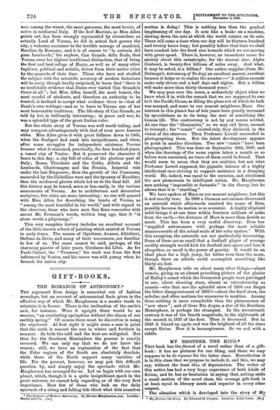GIFT-BOOKS.
TIU ROMANCE OF ASTRONOMY.* THE argument from design is somewhat out of fashion nowadays, but an account of astronomical facts given in the effective way of which Mr. Macpherson is a master tends to reinstate it in favour. There is the inclination of the earth's axis, for instance. Were it upright there would be no seasons, "an everlasting springtime without the charm of our earthly spring." Of course there must be discretion in using the argument. At first sight it might seem a case in point that the earth is nearest the sun in winter and furthest in summer. So both the cold and the heat are mitigated. But then for the Southern Hemisphere the process is exactly reversed. We can only say that we do not know the reason; still, we have an explanation of the fact that the Polar regions of the South are absolutely desolate, while those of the North support many varieties of life. For the present, however, we may put this difficult question by, and simply enjoy the spectacle which Mr. Macpherson has arranged for us. Let us begin with our own planet, which, though it is a quite insignificant speck in the great universe, we cannot help regarding as of the very first importance. How few of those who look on the daily spectacle of a rising and falling tide think what this ceaseless • Ilte Romance of Modern Astronomy. By Hector Macpherson. inn. London : Seeley and Co. [he.] motion is doing ! This is nothing less than the gradual lengthening of our day. It acts like a brake on a machine, slowing down the rate at which the world rotates on its axis. There will come a time when our day will be thirteen hundred and twenty hours long; but possibly before that time we shall have crashed into the fixed star towards which we are moving with great speed. There is, however, no immediate cause for anxiety about this catastrophe, for the nearest star, Alpha Centauri, is twenty-five billions of miles away. And what, it may be asked, is a billion P Our author supplies (from Dr. Dolmage's Astronomy of To-day) an excellent answer, excellent because it helps us to realise the number :—" A million seconds make only eleven and a half days and nights. But a billion will make more than thirty thousand years." We may pass over the moon, a melancholy object when we know what it is, with the remark that we are supposed to owe to it the Pacific Ocean, as filling the place out of which its bulk was scooped, and come to our nearest neighbour, Mars. Our interest in this planet has of late years been greatly increased by speculations as to its being the seat of something like human life. The controversy is not by any means settled. At one time the "illusionists," as we may call them, seemed to triumph; the "canals" existed only, they declared, in the vision of the observer. Then Professor Lowell succeeded in photographing them. But the latest development appears to point in another direction. Two new " canals " have been photographed. This was done on September 30th, 1909, and when the drawings of the same region taken a month or so before were examined, no trace of them could be found. That would seem to mean that they are realities, but not what Professor Lowell supposed, the gigantic labours of a highly intellectual race striving to support existence in a decaying world. He, indeed, was equal to the occasion, and attributed the new phenomena to intelligent action. Mr. Macpherson sees nothing "impossible or fantastic" in the theory, but he allows that it is "startling." We have spoken of Mars as our nearest neighbour, but this is not exactly true. In 1898 a German astronomer discovered an asteroid which afterwards received the name of Eros, possibly because its motion is so eccentric. A highly elliptical orbit brings it at one time within fourteen millions of miles from the earth,—the distance of Mars is more than double as much. This has been a very useful discovery. Eros has "supplied astronomers with perhaps the most reliable measurements of the actual scale of the solar system." With this exception, the asteroids are not particularly interesting. Some of them are so small that a football player of average earthly strength would kick his football into space and lose it altogether, so small is the power of gravity. It would be an ideal place for a high jump, far better even than the moon, though there an athlete could accomplish something like thirty-six feet. Mr. Macpherson tells us about many other things,—about comets, giving ne an almost provoking picture of the glories of Halley's comet which the Greenwich people were privileged to see; about shooting stars, almost as untrustworthy as comets—who that saw the splendid show of 1866 can forget the bitter disappointment of 1899 ?—about the fixed stars, the nebulae, and other matters too numerous to mention. Among these nothing is more remarkable than the phenomenon of "new stars"; and of these Eta Argus, a star of the Southern Hemisphere, is perhaps the strangest. In the seventeenth century it was of the fourth magnitude, in the eighteenth of the second, in 1837 of the first. Then it decreased. But in 1843 it blazed up again and was the brightest of all the stars except Sirius. Now it is inconspicuous. So we end with a riddle.


































































 Previous page
Previous page